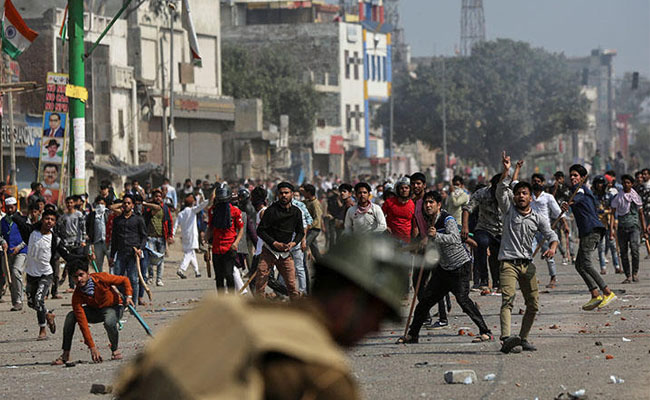Demonstrations are continuing across India following the introduction of the controversial Citizenship Amendment Act (CAA) in December 2019, as reported by The Guardian. Violence has escalated with at least four people killed yesterday, and at least 10 people killed and over 150 injured today, according to news reports. In parts of New Delhi, a Section 144 order has been introduced prohibiting the assembly of four or more people.
Since the protests began in December, security forces have beaten protesters and used lathi sticks, smoke grenades, water cannons, rubber bullets, tear gas, and on occasions live ammunition, according to news reports. In turn, protesters have burnt tires, thrown projectiles such as petrol bombs and rocks, and set fire to numerous vehicles and building
Reporting from protest locations poses various risks to journalists, as documented by CPJ. Over the past two weeks, the protests have become increasingly communal in nature, with some media workers reporting they have been asked about their religious identity, according to reports. Journalists have themselves have demonstrated against the harassment and violence targeted toward them, including detention and arrest, according to reports.
According to reports, police have failed to protect both protesters and journalists on occasions, with some encouraging pro-CAA activists to attack opposing demonstrators. Some journalists have been forced to delete pictures and videos from their phones, and at times have been specifically targeted for their previous reporting, as seen in the case of Mohammed Mubashiruddin Khurram, a reporter with the local Urdu-language newspaper The Siasat Daily, who was arrested while covering a protest earlier in February, CPJ documented.
Current flashpoints in New Delhi include Maujpur, Chandbagh, Ashok Nagar, Yamuna Vihar, Kardampuri, Gautampuri, Jaffrabad, Dayalpur, Bhajanpura, Mustafabad, and Seelampur, according to reports.
Other cities that have witnessed protests against the CAA include, but are not limited to: Chennai (Tamil Nadu), Bhopal (Madhya Pradesh), Agartala (Tripura), Hyderabad (Telangana), Guwahati (Assam), Allahabad and Lucknow (Uttar Pradesh), Ahmedabad (Gujarat), Kolkata and Murshidabad (West Bengal), Bangalore and Mangalore (Karnataka), Mumbai (Maharashtra), Patna (Bihar), and Chandigarh (Punjab), according to news reports and security advisories reviewed by CPJ.
Journalists covering the anti-CAA protests should consider and be aware of the following:
- It is important to note that the protests are potentially becoming more sectarian in nature, a factor to consider when selecting staff for any assignment. Individuals of a different religion to the protesters may encounter hostility and even be attacked.
- If reporting from a protest location, maintain situational awareness at all times and be aware of the threat from potential stampedes. Due to the prevalence of mob violence, consider reporting from a higher vantage point such as a building rooftop or balcony. Always stay in close proximity to hard cover, keep to the periphery of the crowd, and have an emergency exit route planned.
- Consider using a “backwatcher” to help keep you aware of what is going on around you while reporting, taking into account that police have at times failed to protect media workers.
- Always have a check-in procedure with your base, particularly if reporting from protest locations.
- Large crowds create potential risks of sexual assault. Vulnerable journalists should always work with colleagues and have the means to raise the alarm. Working after dark is considerably more risky and should be avoided. For more information please see the CPJ’s solo reporting advice.
- Plan all journeys in and around cities in advance, and have a contingency plan in place. Movement can be affected at very short notice due to protesters blocking roads, as well as the closure of metro stations.
- Satellite phones are illegal in India. Be aware that numerous foreign nationals have been arrested attempting to take one into India.
- If using a drone for filming, which is now permitted in India, they must come with a unique identification number unless listed in the nano category. See here for more information.
- Be alert to the risk of arson, especially if reporting from or close to protest tented camps.
- Ensure all necessary paperwork is applied for in good time. Note that journalists sometimes require additional permits to visit areas such as Assam. Travel to other certain parts of India requires an advance ‘Protected Area Permit’.
- If reporting from areas at high altitude in India, plan your ascent and acclimatization accordingly and do not over-exert yourself. See here for further guidance.
- Consider the necessity of personal protective equipment (PPE), taking into account the increased levels of violence and tactics used by both police and protesters.
- Never take photographs or footage of any state sensitive infrastructure, such as airports, bridges, or military bases.
- Journalists should be aware of a risk to their digital security. Ensure all sensitive data and messages are regularly backed up and wiped from your devices, and ensure your digital devices are secure in advance of travel. Upon leaving the country ensure all devices are cleaned of potential malware or viruses. CPJ’s digital safety kit has steps and resources to protect you and your team.
CPJ’s online Safety Kit provides journalists and newsrooms with basic safety information on physical, digital, and psychological safety resources and tools, including covering civil unrest. If you need assistance, journalists should contact CPJ via emergencies@cpj.org.
